
Musicians are cool! They bring so much joy to our lives with their songs. But music is so much more powerful when it’s loud, and that can be a hearing hazard. Since musicians subject themselves to loud music frequently, their hearing is at an increased risk of being damaged.
Whether your income relies on music or not, you’ll still want to be able to hear your favorite songs when you’re in your later years of life. For musicians, safeguarding their hearing is the key to an extended and successful career. Hearing protection is also key to a lifetime of musical fulfillment for everybody.
Music is surprisingly loud
If you ask most people whether a jet engine is loud, they’ll likely say yes.
But what about music? If you ask someone whether an acoustic guitar or a lone violin is noisy, they may not answer so quickly. Imagine their surprise when they discover the reality: that music is certainly loud! Your ears can even be damaged by classical music which can reach fairly high volumes.
A violin, for instance, can produce sounds well over 90 dB. A leaf blower is around this noisy. To put that into context, the European Union laws stipulate that any workplace noisier than 85 dB will require the use of hearing protection.
And if you’re working with music on a daily basis, constant exposure to that kind of volume, especially without ear protection, can seriously damage your hearing over time.
Can you safeguard your ears from noise damage?
Okay, musicians who want to keep their hearing for years to come need to protect their ears. So what can musicians do to safeguard their hearing and still take pleasure in the music they enjoy so much?
Well, here are a couple of simple things musicians can do:
- Take breaks: Much like any part of your body, your ears can become exhausted and might need a little break. So take frequent breaks from the noise. By doing this, noises won’t overpower and damage your ears. Duration is nearly as important as volume when it comes to hearing health. The difference between the perfect amount of stimulation and too much can come down to taking frequent breaks.
- Track your volume: Knowledge is power, right? So it makes sense that you should always be aware of what levels of sound you’re exposing your ears to. Sometimes, this is as simple as monitoring your volume settings on amps and receivers. But you can also buy a decibel meter app for your smartphone to make it easy to track the real-world volume levels your ears are encountering from day-to-day. If the meter reads above 85dB consistently, you’ll need to address this.
Use hearing protection
Needless to say, the single most beneficial thing you can do to safeguard your hearing is easy: wearing ear protection of some kind. Lots of musicians are worried that ear protection will muffle the sound and effects its overall sound quality. But depending on what kind of hearing protection you use, that may not always be accurate.
- Ear plugs made mainly for musicians: Most individuals are likely familiar with disposable ear plugs. They don’t always fit perfectly, but they do reliably block a lot of sound. They’re inexpensive, easy to get, and easy to dispose of. And they aren’t ideal for musicians. But earplugs just for musicians are also available at a slightly higher cost. These earplugs use fancy manufacturing processes (mostly they’re made out of very distinct materials and are designed to fit comfortably in the ear) to maintain audio clarity while diminishing the noise you hear by around 20dB. For musicians who need a moderate amount of protection on a budget, this option is perfect.
- Electronic earplugs: Electronic earplugs work in basically the same way as high-quality, non-electronic earplugs. The earplug itself will block out most of the sound. What you hear will instead be routed in by the earplug itself. This solution is perfect for individuals who work in particularly loud environments, and who want more options in terms of volume control.
- In-ear monitors: Most music is electronic now, or at least amplified by electronics. A device, known as an in-ear-monitor, is placed in your ear and transmits signals in electronically. It’s like a specialized little speaker for your ear, and the majority of monitors can block out sound from the outside environment (thanks to a fairly tight fit and special design). This means you can hear exactly how you sound, at a volume you control. In-ear monitors are useful for individuals who work mainly with electronically amplified instruments.
Protect your career by protecting your hearing
It’s best to begin protecting your hearing early, before any significant damage occurs. With options available at nearly every price point, there are easy ways for everybody to safeguard their hearing and their future. Remember, ear protection for a musician is an investment in your career. It’s one way to make sure you’ll be making incredible music for years (maybe even decades) to come!
Don’t really know where to start? Give us a call today, we can help!
